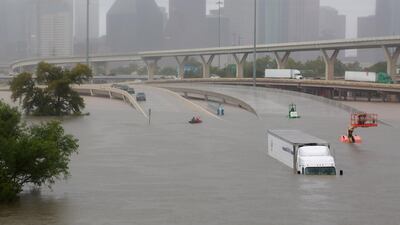Petrol surged to the highest in two years and oil was steady as flooding from Tropical Storm Harvey inundated refining centres along the Texas coast, shutting more than 10 per cent of US fuel-making capacity.
Motor fuel prices rose as much as 6.8 per cent, while oil held gains near US$48 a barrel. Harvey, the strongest storm to hit the United States since 2004, made landfall as a hurricane Friday, flooding cities and shutting plants able to process some 2.26 million barrels of oil a day. Pipelines were closed, potentially stranding some crude in West Texas and starving New York Harbor of petrol.
“Gasoline prices are going to continue to rise this week as we expect another three days of rain in the Houston area,” said Andy Lipow, the president of consultant Lipow OilAssociates in Houston, said by phone. “With pipeline operators beginning to shut down their crude oil and refined product infrastructure, I expect to see further curtailment of refinery operations. A spike in gasoline and diesel prices will drag up crude oil prices.”
Oil has traded this month in the tightest range since February as investors weigh rising global supply against output cuts by members of Opec and its allies. As Harvey led to widespread flooding, Royal Dutch Shell shut its Deer Park plant, while Magellan Midstream Partners suspended its inbound and outbound refined products and crude pipeline transportation services in the Houston area.
Petrol for September delivery climbed as much as 11.33 cents to $1.7799 a gallon on the New York Mercantile Exchange, the highest intraday price for a front-month contract since July 2015. It traded at $1.7621 at 12:36 p.m. in Hong Kong. West Texas Intermediate oil for October delivery fell 16 cents to $47.71 a barrel after advancing 0.9 per cent on Friday.
_______________
Read more:
How will Hurricane Harvey affect US energy sector?
Rivals vie for alternative solutions to conventional diesel
Kuwait's oil minister says OPEC to discuss ending or extending production in November
_______________
Brent crude’s premium to WTI widened to the largest in two years with the global benchmark trading at as much as $4.96 above the US marker. Brent for October settlement gained 18 cents, or 0.3 percent, to $52.59 a barrel on the London-based ICE Futures Europe exchange.
“We’ll see higher pump prices, but I think the crude oilprice is likely to remain more steady,” said Mark Pervan, a Sydney-based chief economist for AME Group. “We’re certainly looking at a slightly different market dynamic than we did last time we had a big weather event like this. The US oil production landscape has moved more onshore essentially, away from the Gulf of Mexico.”
An estimated 300,000 to 500,000 barrels a day of Eagle Ford oil output has been shut, according to the Texas Railroad Commission. About 22 per cent, or 378,600 barrels a day of Gulf of Mexico oil production is offline, according to the Bureau of Safety and Environmental Enforcement. Mr Magellan also said the Longhorn and Bridgetex crude pipelines, capable of hauling a combined 675,000 barrels a day of crude from West Texas to Houston, are shut.

